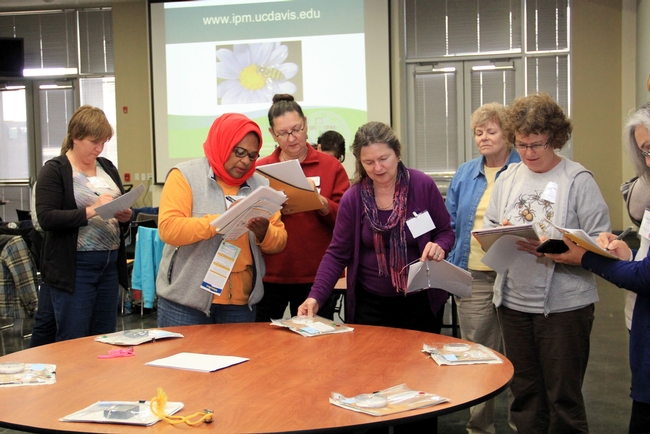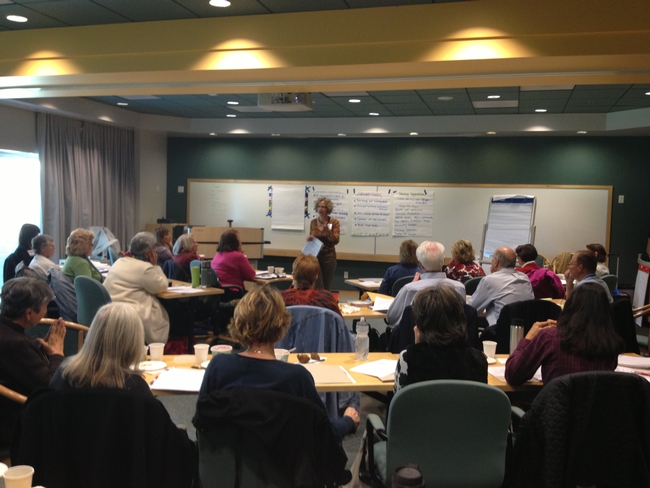From the UC Blogosphere...
Humboldt hosts 'Let's Get Local' farm tours to celebrate centennial
A series of "Let's Get Local' farm tours are running from now till Oct. 12 to mark the centennial of UC Cooperative Extension in Humboldt County, reported the North Coast Journal. Stories about the tours also appeared in the Times-Standard and the Redwood Times.
The tours are designed to show residents a slice of Humboldt County via industries that have sustained the area. Tours cover every aspect of agriculture and other well-known local industries, the article said. For example, in June, UCCE hosted an oyster tour and on July 12, participants got a look at the grass-fed beef industry. A "Veggies and Wine Grapes Tour" takes place Aug. 11 and the Oct. 2 tour features the DG Fairhaven biomass plant.
On Sept. 13, UCCE in Humboldt holds a gala celebration to commemorate its 100-year anniversary. The festivities will go from 5:30 to 9 p.m. at the Arcata Community Center. Dress will be casual, and the event is open to the public. Find details on the Humboldt UCCE website http://cehumboldt.ucanr.edu.
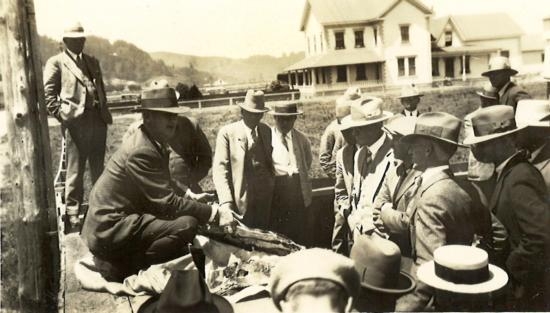
An ag tour with county agricultural agent J.W. Logan, DVM, in 1928.
Happy New (Program) Year!
Happy New Year! I’m sure I’m not the first to welcome you to a new program year for Master Gardener programs statewide, but am I am pleased to share with you some exciting news from this past year now that the dust of recertification has settled. Program Year 2012-1013 was a busy one for California Master Gardeners, as I’m sure you’ll see for yourself from the numbers below! Last July 1st marked the first time all 45 Master Gardener programs recertified at the same time of the year, and since then we’ve been going like gang busters! Just check out some of the amazing things that UC Master Gardeners did in the last year!
Program rosters now tell us that statewide we have 5,404 volunteers who dedicate themselves to extending UC research-based home horticulture information to the public. Programs range in size from fourteen to over three hundred Master Gardeners, but the thing they all have in common is their passion for horticulture and the desire to not only learn more, but share what they learn with other Californians. From July 1, 2012-June 30, 2013 UC MGs donated over 348,132 volunteer hours to their respective communities. If we want to think about this monetarily (and who doesn’t?!), the value of this time to UC ANR comes in at over $8.6 million!* Another way to think of it, is to compare these hours to current resources UCCE has at its disposal. As of this last year the University of California Cooperative Extension had 171 advisors listed in the directory that were categorized as specializing in “Plant Commodities or Products” –only forty of which specialized in “Ornamental Plants, Landscape, and Turf”. When we compare the staggering number of volunteer hours, we find that this figure equates to approximately 180 full time employees** for the University of California. In effect, with the Master Gardener program in place, we more than double our “staff” available to answer plant and pest-related queries from the public and provide that invaluable arm of extension by connecting California residents with UC research.
Volunteering for their communities is not the only way UC Master Gardeners spend their time, however. Last year over 76,480 hours were logged in continuing education as Master Gardeners worked to keep themselves informed about new or advanced horticultural topics and trends. In addition to presentations and workshops presented at the local program level, the Statewide Master Gardener Program hosted six 2-day regional trainings on Edible Landscaping and four regional workshops on Advanced Citrus and Avocado Care (including special focus on new citrus threat, Asian Citrus Psyllid). The Statewide UC IPM program also hosted opportunities for Master Gardeners to expand their knowledge of home and garden pests and treatment options via three regional Advanced IPM trainings.
The volunteers aren’t the only ones putting in the hours, though! The Statewide Master Gardener Program has also been hard at work this year working to support and provide developmental opportunities for the 45 Master Gardener programs around the state. One of the most exciting ways we were able to offer support in the last year and moving forward was a grant opportunity for programs to seek partial or full funding for a Program Representative (local MG coordinator) position starting July 1, 2013 and continuing through June of 2015. Many applications were submitted and in total the grant funded 19 county-based positions, including one brand new program that will take shape in the Lassen, Sierra, and Plumas counties. In order to aid programs in continued development, the Statewide Master Gardener Program also hosted 13 webinars and a two-day training for Program Coordinators, ranging in topics from best practices for Social Media to Volunteer Recognition. In November 2012 the Statewide Program also hosted the first ever Volunteer Leadership Summit, in which we invited each program to send a Master Gardener volunteer who was directly involved with the leadership of the local program to attend a day-long training on Middle Management topics and provide an opportunity for networking across counties.
It certainly has been a year of many triumphs for the UC Master Gardener Program. Thank you for the time and effort that you put into this program. We are continually astounded by the work that is accomplished by California Master Gardeners and feel extremely lucky to work with such talented and selfless individuals. We look forward to another incredibly successful year and can’t wait to chart the leaps and bounds we are sure to take statewide this year!
*Value of volunteer time found by using Independent Sector estimate of $24.75/hour in California. Find current rate at: http://www.independentsector.org/programs/research/volunteer_time.html
** assumes 1928 working hours per year.
Asian Citrus Psyllid Found on Tulare Traps in June
This information is in from Tulare County:
The California Department of Food and Agriculture (CDFA) announced yesterday that six adult Asian citrus psyllids (ACP) were found in three separate Glassy-winged sharpshooter traps in commercial citrus groves in southwest Porterville. The traps were set on June 11 and serviced on June 26. CDFA and Tulare County are establishing an eight square mile intensive trapping zone around the detections to determine if there may be other ACP in the vicinity.
CDFA, USDA/APHIS and County of Tulare will be meeting to determine the appropriate course of action and whether to impose a quarantine zone or other regulatory measures. CDFA will meet Monday (July 15) with the Executive Committee of the Citrus Pest and Disease Management Committee regarding its plans for addressing the infestation.
More information will be provided as it becomes available.
Terrific example of communities and researchers uniting
Californians are surrounded by plants that were developed by researchers. If you are from Santa Rosa, you are probably familiar with Luther Burbank. Burbank developed many varieties that we enjoy today including the plumcot, the shasta daisy and hundreds of other fruits, vegetables, and ornamentals.
In addition to Burbank, researchers and California homeowners have brought new plants to our backyards. Right now, one of those plants is being threatened by the Asian Citrus Psyllid and the disease, Huanglongbing. A tree that was the original parent to the navel oranges we enjoy is located at the heart of the psyllid outbreak - in Riverside. Everyone is trying to save it.
Read how at http://plantingseedsblog.cdfa.ca.gov/wordpress/?p=4318
Listen to the California Report of this story at http://www.californiareport.org/archive/R201307051630/b
Purple Coneflower Never Looked So Good
You never know what you'll see on a purple coneflower (Echinacea purpurea).Honey bees. Check. Sweat bees....
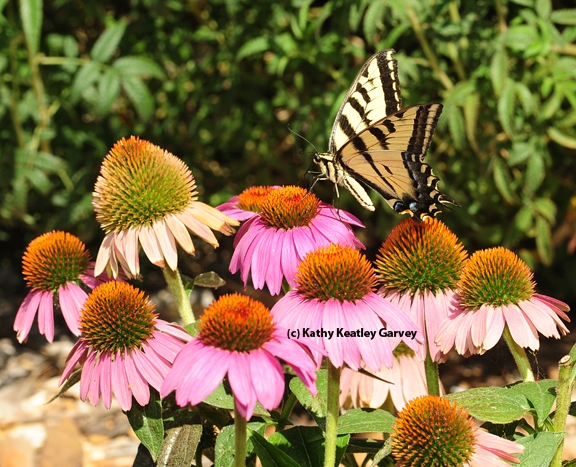
Western tiger swallowtail on a purple coneflower. (Photo by Kathy Keatley Garvey)
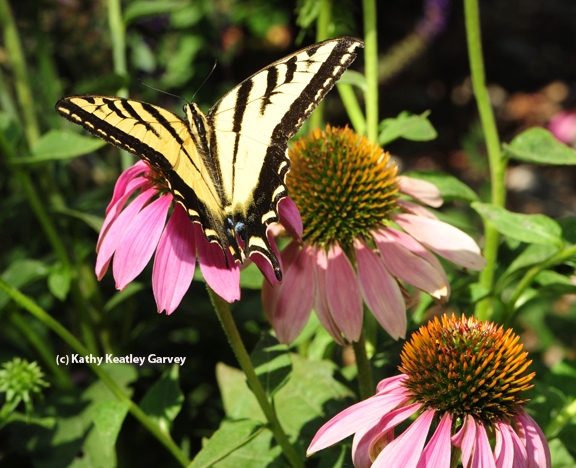
Western tiger swallowtail spreads its wings. (Photo by Kathy Keatley Garvey)




